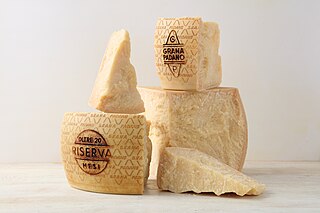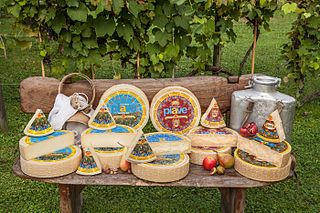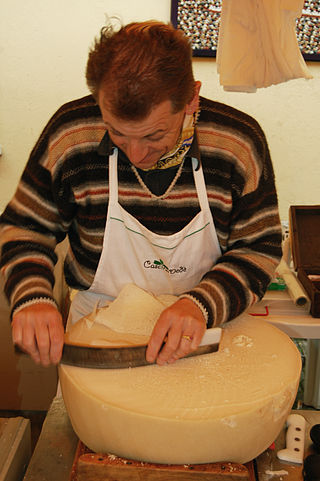
Pecorino romano is a hard, salty Italian cheese made from sheep's milk, often used for grating over pasta or other dishes. The name pecorino means 'ovine' or 'of sheep' in Italian; the name of the cheese, although protected, is a description rather than a brand: [formaggio] pecorino romano means 'sheep's [cheese] of Rome'.

Pesto or more fully pesto alla genovese is a paste made of crushed garlic, pine nuts, salt, basil leaves, grated cheese such as Parmesan or pecorino sardo, and olive oil. It originated in the Italian city of Genoa, and is used to dress pasta and flavour genoese minestrone soup.

Parmesan is an Italian hard, granular cheese produced from cow's milk and aged at least 12 months or, outside the European Union and Lisbon Agreement countries, a locally produced imitation.

Carbonara is a pasta dish made with fatty cured pork, hard cheese, eggs, salt, and black pepper. It is typical of the Lazio region of Italy. The dish took its modern form and name in the middle of the 20th century.

A kitchen knife is any knife that is intended to be used in food preparation. While much of this work can be accomplished with a few general-purpose knives — notably a large chef's knife and a smaller serrated blade utility knife — there are also many specialized knives that are designed for specific tasks such as a tough cleaver, a small paring knife, and a bread knife. Kitchen knives can be made from several different materials, though the commonest is a hardened steel blade with a wooden handle.

Grana Padano is a cheese originating in the Po Valley, in northern Italy. It is similar to Parmesan but with less strict regulations governing its production. This hard, crumbly-textured cheese is made with unpasteurized cows' milk that is semi-skimmed. To preserve the authenticity of the manufacturing processes and raw materials used to make this cheese, Grana Padano was registered as a denominazione di origine controllata (DOC) in 1955, and as a European Union protected designation of origin (PDO) in 1996. Outside of the EU, its name is protected in several other countries based on the Lisbon Agreement and bilateral agreements.

Piave is an Italian cow's milk cheese that is named after the Piave river. As Piave has a protected designation of origin (DOP), the only "official" Piave is produced in the Dolomites area, province of Belluno, in the northernmost tip of the Veneto region.

Balearic cuisine is a Mediterranean cuisine as cooked in the Balearic Islands, Spain. It can be regarded as part of a wider Catalan cuisine, since it shares many dishes and ingredients with Catalonia and the Valencian Community. Others view it as part of a more global Spanish cuisine. Traditional Balearic cuisine is rich in vegetables, cereal and legumes as well as being low in fats. A succinct selection of the primary dishes would be ensaimades, seafood and vegetable stews, sobrassada, coques, tombet, Maó cheese and wine.
Grana is a type of hard, mature cheese from Italy with a granular texture, often used for grating. Grana cheeses are typically made in the form of large wheels. The structure is often described as crystalline, and the wheels are divided by being split with a fairly blunt almond-shaped knife designed for the purpose, rather than being sliced, cut or sawn. Within the European Union the term grana is legally protected by Grana Padano protected designation of origin (PDO); only Grana Padano may be sold using the term in EU countries.

Castelmagno (DOP) is an Italian cheese originating from the Piedmont region. It has a protected designation of origin status in the European Union.
Indians in Italy comprise the second largest population of Indians in Continental Europe, after Indians in Germany. Although Italy and India have maintained important relations since ancient times, significant Indian migration to Italy is a recent phenomenon. Many Indians began immigrating to Italy in the early 1990s, when the Italian government initiated programs to get Indian IT professionals and engineers to contribute to the technology sector in Italy. Most Indian immigrants came to Italy legally.

There are many different types of cheese, which can be grouped or classified according to criteria such as: length of fermentation, texture, production method, fat content, animal source of the milk, and country or region of origin. These criteria may be used either singly or in combination, with no method used universally. The most common traditional categorization is based on moisture content, which is then further narrowed down by fat content and curing or ripening methods.

A cheese knife is a type of kitchen knife specialized for the cutting of cheese. Different cheeses require different knives, according primarily to hardness. There are also a number of other kitchen tools designed for cutting or slicing cheese, especially the harder types. These include the cheese cutter, cheese slicer, cheese plane, cheese scoop for soft cheese and others, collectively known as cheese servers.

Pecorino toscano is a firm-textured ewe's milk cheese originating in the Tuscany region of Italy. Since 1996 it has enjoyed protected designation of origin (PDO) status.

Cheese crystals are whitish, semi-solid to solid, slightly crunchy to gritty crystalline spots, granules, and aggregates that can form on the surface and inside of cheese. Cheese crystals are characteristic of many long-aged hard cheeses.

Swiss-type cheeses, also known as Alpine cheeses, are a group of hard or semi-hard cheeses with a distinct character, whose origins lie in the Alps of Europe, although they are now eaten and imitated in most cheesemaking parts of the world. Their distinct character arose from the requirements of cheese made in the summer on high Alpine grasslands, and then transported with the cows down to the valleys in the winter, in the historic culture of Alpine transhumance. Traditionally the cheeses were made in large rounds or "wheels" with a hard rind, and were robust enough for both keeping and transporting.
Zuppa pavese or zuppa alla pavese is an Italian soup consisting of broth into which slices of stale bread and poached eggs are placed. It is generally served with grated Parmesan. Usually in Lombardy either Grana Padano or Granone Lodigiano are used.

Pizza quattro formaggi, also known as pizza ai quattro formaggi, is a variety of pizza in Italian cuisine that is topped with a combination of four types of cheese, usually melted together, with or without tomato sauce. It is popular worldwide, including in Italy, and is one of the iconic items from pizzerias' menus.

Raspadüra is a way to serve grana cheese, presenting it as very thin sheets, scraped with a special knife from a wheel of Granone Lodigiano or from a "young" cheese of the grana family, that is aged from four to six months.
















